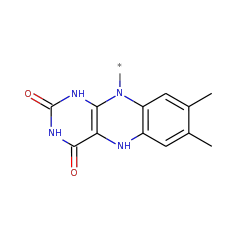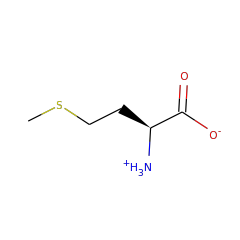This family of enzymes is responsible for the creation of a glycyl radical in the ground state of the enzyme 4-hydroxyphenylacetate decarboxylase. This enzyme is unique amongst the glycyl radical enzymes in having a small subunit and being a functional hetero-octamer (made up of four large subunits and four small subuints) in the biologically active state. The small subunit is responsible for metal binding and is also involved in the regulation of the enzymes' oligomeric state and activity, which are triggered by reversible serine phosphorylation of the glycyl radical subunits. These enzymes differ from their PFL-AE and Nrd counterparts in that they contain up to two iron-sulfur centres, in addition to the characteristic SAM cluster, these extra clusters are thought to be involved in the electron transfer to the SAM cluster but do not directly participate in the reductive cleavage of SAM.
Martins BM, Blaser M, Feliks M, Ullmann GM, Buckel W, Selmer T
Structural basis for a Kolbe-type decarboxylation catalyzed by a glycyl radical enzyme
▸ Abstract
4-Hydroxyphenylacetate decarboxylase is a [4Fe-4S] cluster containing glycyl radical enzyme proposed to use a glycyl/thiyl radical dyad to catalyze the last step of tyrosine fermentation in clostridia. The decarboxylation product p-cresol (4-methylphenol) is a virulence factor of the human pathogen Clostridium difficile . Here we describe the crystal structures at 1.75 and 1.81 Å resolution of substrate-free and substrate-bound 4-hydroxyphenylacetate decarboxylase from the related Clostridium scatologenes . The structures show a (βγ)(4) tetramer of heterodimers composed of a catalytic β-subunit harboring the putative glycyl/thiyl dyad and a distinct small γ-subunit with two [4Fe-4S] clusters at 40 Å distance from the active site. The γ-subunit comprises two domains displaying pseudo-2-fold symmetry that are structurally related to the [4Fe-4S] cluster-binding scaffold of high-potential iron-sulfur proteins. The N-terminal domain coordinates one cluster with one histidine and three cysteines, and the C-terminal domain coordinates the second cluster with four cysteines. Whereas the C-terminal cluster is buried in the βγ heterodimer interface, the N-terminal cluster is not part of the interface. The previously postulated decarboxylation mechanism required the substrate's hydroxyl group in the vicinity of the active cysteine residue. In contrast to expectation, the substrate-bound state shows a direct interaction between the substrate's carboxyl group and the active site Cys503, while His536 and Glu637 at the opposite side of the active site pocket anchor the hydroxyl group. This state captures a possible catalytically competent complex and suggests a Kolbe-type decarboxylation for p-cresol formation.
J Am Chem Soc
2011;133(37):14666-14674
| PubMed ID:
21823587
Yu L, Blaser M, Andrei PI, Pierik AJ, Selmer T
4-Hydroxyphenylacetate decarboxylases: properties of a novel subclass of glycyl radical enzyme systems
▸ Abstract
The 4-hydroxyphenylacetate decarboxylases from Clostridium difficile and Clostridium scatologenes, which catalyze the formation of p-cresol, form a distinct group of glycyl radical enzymes (GREs). Cresol formation provides metabolic toxicity, which allows an active suppression of other microbes and may provide growth advantages for the producers in highly competitive environments. The GRE decarboxylases are characterized by a small subunit, which is not similar to any protein of known function in the databases, and provides unique properties that have not been observed in other GREs. Both decarboxylases are functional hetero-octamers (beta(4)gamma(4)), which contain iron-sulfur centers in addition to the glycyl radical prosthetic group. The small subunit is responsible for metal binding and is also involved in the regulation of the enzymes' oligomeric state and activity, which are triggered by reversible serine phosphorylation of the glycyl radical subunits. Biochemical data suggest that the iron-sulfur centers of the decarboxylases could be involved in the radical dissipation of previously activated enzymes in the absence of substrate. The cognate activating enzymes differ from their Pfl and Nrd counterparts in that up to two iron-sulfur centers, in addition to the characteristic SAM cluster, were found. Biochemical data suggested that these [4Fe-4S] centers are involved in the electron transfer to the SAM cluster but do not directly participate in the reductive cleavage of SAM. These data imply a tight regulation of p-cresol formation, which is necessary in order to avoid detrimental effects of the toxic product on the producers.
Biochemistry
2006;45(31):9584-9592
| PubMed ID:
16878993
Andrei PI, Pierik AJ, Zauner S, Andrei-Selmer LC, Selmer T
Subunit composition of the glycyl radical enzyme p-hydroxyphenylacetate decarboxylase. A small subunit, HpdC, is essential for catalytic activity
▸ Abstract
p-Hydroxyphenylacetate decarboxylase from Clostridium difficile catalyses the decarboxylation of p-hydroxyphenylacetate to yield the cytotoxic compound p-cresol. The three genes encoding two subunits of the glycyl-radical enzyme and the activating enzyme have been cloned and expressed in Escherichia coli. The recombinant enzymes were used to reconstitute a catalytically functional system in vitro. In contrast with the decarboxylase purified from C. difficile, which was an almost inactive homo-dimeric protein (beta(2)), the recombinant enzyme was a hetero-octameric (beta(4)gamma(4)), catalytically competent complex, which was activated using endogenous activating enzyme from C. difficile or recombinant activating enzyme to a specific activity of 7 U.mg(-1). Preliminary results suggest that phosphorylation of the small subunit is responsible for the change of the oligomeric state. These data point to an essential function of the small subunit of the decarboxylase and may indicate unique regulatory properties of the system.
Eur J Biochem
2004;271(11):2225-2230
| PubMed ID:
15153112
Selvaraj B, Pierik AJ, Bill E, Martins BM
4-Hydroxyphenylacetate decarboxylase activating enzyme catalyses a classical S-adenosylmethionine reductive cleavage reaction
▸ Abstract
4-Hydroxyphenylacetate decarboxylase (4Hpad) is an Fe/S cluster containing glycyl radical enzyme (GRE), which catalyses the last step of tyrosine fermentation in clostridia, generating the bacteriostatic p-cresol. The respective activating enzyme (4Hpad-AE) displays two cysteine-rich motifs in addition to the classical S-adenosylmethionine (SAM) binding cluster (RS cluster) motif. These additional motifs are also present in other glycyl radical activating enzymes (GR-AE) and it has been postulated that these orthologues may use an alternative SAM homolytic cleavage mechanism, generating a putative 3-amino-3-carboxypropyl radical and 5'-deoxy-5'-(methylthio)adenosine but not a 5'-deoxyadenosyl radical and methionine. 4Hpad-AE produced from a codon-optimized synthetic gene binds a maximum of two [4Fe-4S](2+/+) clusters as revealed by EPR and Mössbauer spectroscopy. The enzyme only catalyses the turnover of SAM under reducing conditions, and the reaction products were identified as 5'-deoxyadenosine (quenched form of 5'-deoxyadenosyl radical) and methionine. We demonstrate that the 5'-deoxyadenosyl radical is the activating agent for 4Hpad through p-cresol formation and correlation between the production of 5'-deoxyadenosine and the generation of glycyl radical in 4Hpad. Therefore, we conclude that 4Hpad-AE catalyses a classical SAM-dependent glycyl radical formation as reported for GR-AE without auxiliary clusters. Our observation casts doubt on the suggestion that GR-AE containing auxiliary clusters catalyse the alternative cleavage reaction detected for glycerol dehydratase activating enzyme.
J Biol Inorg Chem
2013;18(6):633-643
| PubMed ID:
23716017
Selvaraj B, Pierik AJ, Bill E, Martins BM
The ferredoxin-like domain of the activating enzyme is required for generating a lasting glycyl radical in 4-hydroxyphenylacetate decarboxylase
▸ Abstract
4-Hydroxyphenylacetate decarboxylase-activating enzyme (4Hpad-AE) uses S-adenosylmethionine (SAM or AdoMet) and a [4Fe-4S](2+/+) cluster (RS cluster) to generate a stable glycyl radical on the decarboxylase. 4Hpad-AE might bind up to two auxiliary [4Fe-4S] clusters coordinated by a ferredoxin-like insert C-terminal to the RS cluster-binding motif. Except for the AEs of pyruvate formate-lyase and anaerobic ribonucleotide reductase, all glycyl radical-activating enzymes possess a similar ferredoxin-like domain, whose functional role is still poorly understood. To assess the role of the putative ferredoxin clusters from 4Hpad-AE, we combined biochemical and spectroscopic methods to characterize a truncated version of the protein (Δ66-AE) devoid of the ferredoxin-like domain. We found that Δ66-AE is stable, harbors a fully active RS cluster and can activate the decarboxylase. From the similar cleavage rates for S-adenosylmethionine of Δ66-AE and wild-type AE, we infer the reactivity of the RS cluster is unperturbed by the absence of the ferredoxin-like domain. Thus, the auxiliary clusters are not required as electron conduit to the RS cluster for effective reductive cleavage of SAM. The activation of the decarboxylase by Δ66-AE is almost as fast as with wild-type AE, but the generated glycyl radical is short living. We postulate that the ferredoxin-like domain is not required for SAM-dependent glycyl radical generation in the decarboxylase, but is necessary for producing a lasting glycyl radical.
J Biol Inorg Chem
2014;None(None):None-None
| PubMed ID:
25156152
Selvaraj B, Buckel W, Golding BT, Ullmann GM, Martins BM
Structure and Function of 4-Hydroxyphenylacetate Decarboxylase and Its Cognate Activating Enzyme
▸ Abstract
4-Hydroxyphenylacetate decarboxylase (4Hpad) is the prototype of a new class of Fe-S cluster-dependent glycyl radical enzymes (Fe-S GREs) acting on aromatic compounds. The two-enzyme component system comprises a decarboxylase responsible for substrate conversion and a dedicated activating enzyme (4Hpad-AE). The decarboxylase uses a glycyl/thiyl radical dyad to convert 4-hydroxyphenylacetate into p-cresol (4-methylphenol) by a biologically unprecedented Kolbe-type decarboxylation. In addition to the radical dyad prosthetic group, the decarboxylase unit contains two [4Fe-4S] clusters coordinated by an extra small subunit of unknown function. 4Hpad-AE reductively cleaves S-adenosylmethionine (SAM or AdoMet) at a site-differentiated [4Fe-4S]2+/+ cluster (RS cluster) generating a transient 5'-deoxyadenosyl radical that produces a stable glycyl radical in the decarboxylase by the abstraction of a hydrogen atom. 4Hpad-AE binds up to two auxiliary [4Fe-4S] clusters coordinated by a ferredoxin-like insert that is C-terminal to the RS cluster-binding motif. The ferredoxin-like domain with its two auxiliary clusters is not vital for SAM-dependent glycyl radical formation in the decarboxylase, but facilitates a longer lifetime for the radical. This review describes the 4Hpad and cognate AE families and focuses on the recent advances and open questions concerning the structure, function and mechanism of this novel Fe-S-dependent class of GREs.
J Mol Microbiol Biotechnol
2016;26(1):76-91
| PubMed ID:
26959876












